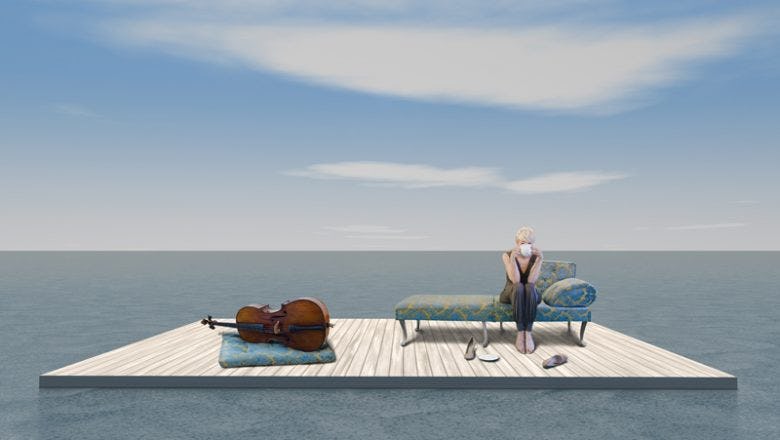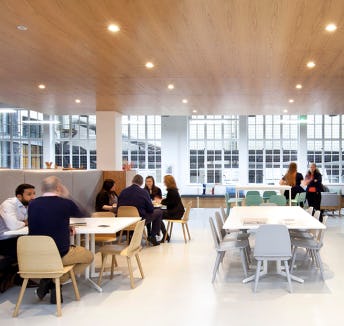
TedXAmsterdam speaker Jacqueline Hamelink is a cellist who can’t seem to sit still. Originally working in the classical music world, she is always passionate about exploring new musical idioms and a wide range of theatrical forms. Inspired by musical theatre, she moves on the edge of music, dance, theatre and visual art.
We talk to Jacqueline about music as therapy, and some of the work she does.
Spaces: Hi Jacqueline, through your work you communicate meaning through the language of music. Could you share with us how you came up with the idea of Bach as therapy?
Jacqueline: Although I think that art and therapy are two very different things, for me as a performance artist the idea of therapy is very interesting. Therapy is about giving, receiving and healing. In BachTherapy!, I want to redefine these ideas as an artistic concept. When thinking about spacing a performance or the relation between performer and audience, artists often limit themselves to the dramaturgical rules of their discipline. I like to break out of that.
By looking at non-artistic practice, like therapy, I discover new ways doing things artistically. Funny enough, this works like therapy for me too! The choice to use Bach’s music in the performance came quite naturally to me, because there is something innately therapeutic about his composition style. It is really Bach’s intention to let you experience a range of emotions. The way in which his music brings you in touch with feelings really works like a process of healing: The healing power of beauty!
Tell us more about you “total surrender” idea. Why do you think it is so therapeutic?
It’s wonderful people experience this performance as therapeutic, the idea behind the BachTherapy! TotalSurrender is primarily artistic. I think that the most difficult aspect of performance art is not to communicate an idea; you can tell an idea and either the audience agrees with it or not. The true artistic challenge is to communicate feeling. This is much harder, because you need to get the body of the listener involved in the performance.
My idea is that when you’re kneeling in front of me, sitting even closer to the cello than I am, I literally take away the space between the listener and the music. By holding the cello you not only get an auditive experience, but also a physical one. The vibrations of the cello travel through your entire body. It allows me to directly communicate to your body, and not to allow the ratio to interfere.
What is your aim in using music in a holistic way?
Music is such a strong emotional language that it never fails to communicate. Communication often fails because we fail to listen, because our words are limited, or simple because we don’t have enough time to really engage with other people’s ideas. Because of its harmony, music appeals to us immediately.
I must say though, that this is not only truth of Bach’s classically composed music, but also of contemporary music. I am a massive fan of contemporary music, and I think it is pity that many see this music as difficult. I am working on new performance to show the beauty of some very contemporary pieces written for cello solo.
What inspires you most in your work?
The responses I get from people that see my performances. For me, a performance is successful when I succeed in really communicating my idea with the audience. When they feel what I hoped them to feel.
Can you tell us about the concept of your startup, Sounding Bodies?
I founded Sounding Bodies in 2012 to create my own performances. Originally, I’m a classically trained cellist and I have worked in the field of classical music for some time. Many years ago, I accidentally landed on a job as a musician in contemporary music theatre play. I was so struck by their holistic and creative approach to art, that I decided that same day I wanted to be a performer.
I started taking singing lessons, I took dancing and acting classes, and I started working more and more with theatre directors, choreographers, visual artists, etc. Working with many different theatre, dance and music companies as a cellist/performer, I wanted to make interdisciplinary performances that breath my personal style. I am so happy that this dream is now becoming reality.
What are some of the best experiences and most special moments you’ve had with your work?
In my line of work, there are of course many special moments. For me, personally, one very special moment this year was that I was invited to play my most recent performance Ivory Tower, which I created together with visual artist Miesjel van Gerwen, at a festival in South Africa.
I have done international touring as a musician, but now for the first time with one of my own creations. At the festival, one of the funniest experiences was that one man saw the performance and wanted to give it to his wife as a present. So the next day, he booked an entire show just for him and his wife!
What are you most looking forward to about your talk at Spaces Vijzelstraat?
Meeting new people that can bring me forward in my artistic quest. Sharing my ideas with such creative people will definitively help me to develop them further and perhaps use them in my next performance. Of course, I also look very much to performing “From Silent Glass” with them. It is the first performance I made for Sounding Bodies. It is created on the spot, together with the audience and always gives great pleasure and atmosphere.
Great, thanks Jacqueline.
We welcome Jacqueline as our special guest speaker during our TEDxAmsterdam & Spaces event on 12th May, in the business club of Spaces Vijzelstraat. Jacqueline will be sharing her story and experiences.
Not lucky enough to get tickets to this sold out event? Keep your eye on our events page for what’s to come this summer.
Share this article
 Read now How to Integrate Your Lifestyle in Your Work
Read now How to Integrate Your Lifestyle in Your Work
 Read now Creative Boosts for the Brain
Read now Creative Boosts for the Brain